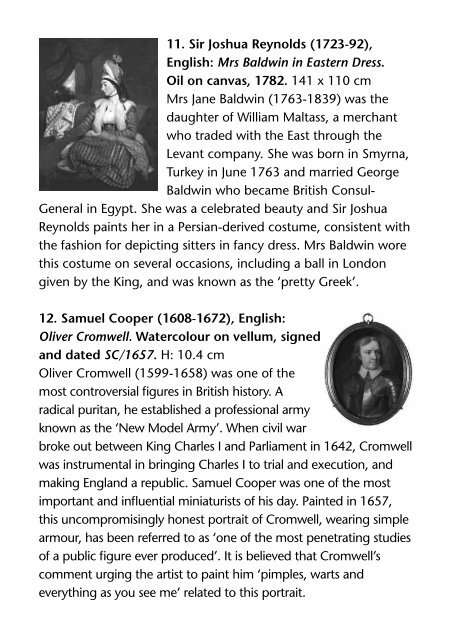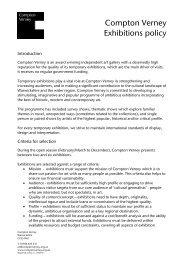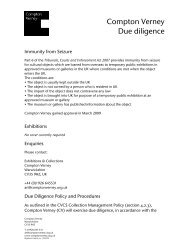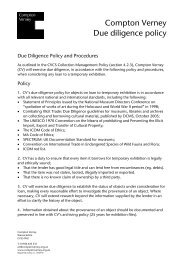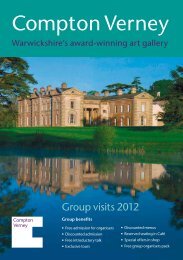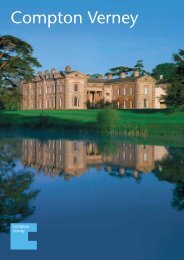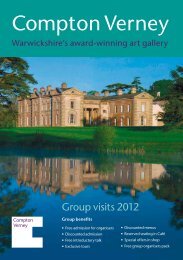Read the gallery guide - Compton Verney
Read the gallery guide - Compton Verney
Read the gallery guide - Compton Verney
Create successful ePaper yourself
Turn your PDF publications into a flip-book with our unique Google optimized e-Paper software.
11. Sir Joshua Reynolds (1723-92),<br />
English: Mrs Baldwin in Eastern Dress.<br />
Oil on canvas, 1782. 141 x 110 cm<br />
Mrs Jane Baldwin (1763-1839) was <strong>the</strong><br />
daughter of William Maltass, a merchant<br />
who traded with <strong>the</strong> East through <strong>the</strong><br />
Levant company. She was born in Smyrna,<br />
Turkey in June 1763 and married George<br />
Baldwin who became British Consul-<br />
General in Egypt. She was a celebrated beauty and Sir Joshua<br />
Reynolds paints her in a Persian-derived costume, consistent with<br />
<strong>the</strong> fashion for depicting sitters in fancy dress. Mrs Baldwin wore<br />
this costume on several occasions, including a ball in London<br />
given by <strong>the</strong> King, and was known as <strong>the</strong> ‘pretty Greek’.<br />
12. Samuel Cooper (1608-1672), English:<br />
Oliver Cromwell. Watercolour on vellum, signed<br />
and dated SC/1657. H: 10.4 cm<br />
Oliver Cromwell (1599-1658) was one of <strong>the</strong><br />
most controversial figures in British history. A<br />
radical puritan, he established a professional army<br />
known as <strong>the</strong> ‘New Model Army’. When civil war<br />
broke out between King Charles I and Parliament in 1642, Cromwell<br />
was instrumental in bringing Charles I to trial and execution, and<br />
making England a republic. Samuel Cooper was one of <strong>the</strong> most<br />
important and influential miniaturists of his day. Painted in 1657,<br />
this uncompromisingly honest portrait of Cromwell, wearing simple<br />
armour, has been referred to as ‘one of <strong>the</strong> most penetrating studies<br />
of a public figure ever produced’. It is believed that Cromwell’s<br />
comment urging <strong>the</strong> artist to paint him ‘pimples, warts and<br />
everything as you see me’ related to this portrait.<br />
13. Lemuel Francis Abbott (1760-1802):<br />
Horatio, Admiral Nelson, KB.<br />
Oil on canvas,1797. 76.2 x 63.5 cm<br />
Painted shortly after Nelson lost his arm in a<br />
battle at Santa Cruz, Tenerife, this portrait was<br />
commissioned by his Captain, William Locker<br />
while Nelson was convalescing at Locker’s<br />
home in Greenwich.<br />
14. Jean-Étienne Liotard (1702-89),<br />
Swiss: Lady Fawkener. Pastel on vellum,<br />
about 1760. 73.6 x 58.8 cm<br />
The sitter is Harriet Churchill, <strong>the</strong> wife of Sir<br />
Everard Fawkener, English ambassador to<br />
Constantinople (now Istanbul) from 1737 to 1746. Fawkener and<br />
<strong>the</strong> Swiss pastel painter had become acquainted in <strong>the</strong> Turkish<br />
capital, where <strong>the</strong> artist produced portraits for members of <strong>the</strong><br />
British colony. In <strong>the</strong> mid-1750s <strong>the</strong> two met again in London,<br />
where this delicate portrait is thought to have been produced.<br />
15. After a bust by Gianlorenzo Bernini, English:<br />
King Charles I. Lead, about 1675. H: 66 cm<br />
This important piece is one of only three versions<br />
known to be in existence, taken from a marble bust<br />
by Gianlorenzo Bernini which was destroyed in <strong>the</strong><br />
Whitehall Palace fire of 1698. Although <strong>the</strong><br />
sculptor of this bust is undetermined, one suggested<br />
possibility is John Bushnell (1636-1701). Bushnell<br />
trained in Italy before returning to England in 1668/69, and in<br />
1671 created a statue of Charles I in Purbeck stone, which is also<br />
thought to be based on Bernini’s bust.


